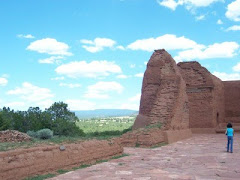
You can see that the air intake (little rectangular door in the wall), the stones that block air from the air intake, the fire pit and the sipapu are all in a line. An interpretation of sipapu, which is a Hopi word, is that the spot served as the symbolic place of origin of the tribe. You may also find an interesting description of the "entrance to the fourth world" aspect here.
And yes, the word was appropriated as the name of a New Mexico resort (their odd tagline is: "Find it. Ski it." located about 20 miles from Taos).
Here is a helpful excerpt from the thoughtful and detailed paper, "Where Earth and Sky Meet" by John A. Blackwell:
"The Hopi people, one of the remaining Pueblo Cultures of the American southwest, have a very complex cosmology, one that is similar to what is believed to be that of the ancient Anasazi. They believe themselves to be the descendants of the inhabitants of three previous worlds and that through a series of emergences, they are now living on the surface of the fourth world called Tuwaqachi (Waters 21). This place of emergence is symbolized in the sacred kiva structure by the sipapu, a hole in the ground dug as a reminder. In fact, the kiva itself represents an entire cosmological model to the Pueblo Indians.
The kiva was and still is a sacred building for the Indians. Most are small circular structures burried in the ground with stone walls and wood and mud daub roofs. The smaller ones typically have an opening in the roof through which a ladder can be used

to descend into the kiva. Larger kivas had stairways leading down into them but still had the roof hole to allow smoke from the fire, burning in the kiva's fire pit, to escape. Some later kivas even had fairly complex ventilation systems with holes and shafts running to the surface. Kivas ranged in size from 20 foot diameter structures to larger than 50 feet across at sites like Chetro Ketl in Chaco Canyon.  It is believed that they originally served as kin group meeting places or even dwelling units and then later became religious centers. Many were aligned with entrances and vent shafts running due north and south.
It is believed that they originally served as kin group meeting places or even dwelling units and then later became religious centers. Many were aligned with entrances and vent shafts running due north and south.
 The sipapu represents the emergence place, the walls the sky, and the roof the Milky Way (Malville 8). In fact some kivas belonging to the Pueblo Indians had complex wall paintings displaying astronomical symbols (Williamson 190) [we have not seen this in our kiva travels]. The roof of the kiva was typically supported by four posts, which according to Malville, could have represented the four cardinal directions, "the four trees planted in the underworld or the four sacred mountains" (8). Even the ladder used to climb into and out of the kiva could be considered a symbol of the emergence with the ritualization of emergence being performed whenever someone climbed out of the kiva (Williamson 71)."
The sipapu represents the emergence place, the walls the sky, and the roof the Milky Way (Malville 8). In fact some kivas belonging to the Pueblo Indians had complex wall paintings displaying astronomical symbols (Williamson 190) [we have not seen this in our kiva travels]. The roof of the kiva was typically supported by four posts, which according to Malville, could have represented the four cardinal directions, "the four trees planted in the underworld or the four sacred mountains" (8). Even the ladder used to climb into and out of the kiva could be considered a symbol of the emergence with the ritualization of emergence being performed whenever someone climbed out of the kiva (Williamson 71)."Our photos in descending order: Mesa Verde sipapu; Pecos NM kiva; long view of Chaco Canyon.








